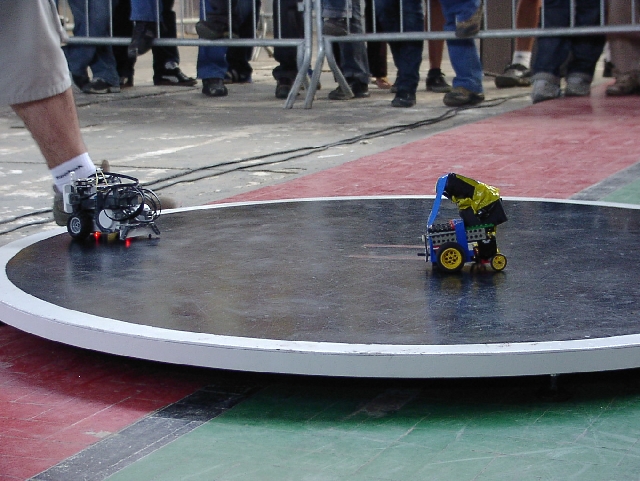Sumo aliases here.
From the Wikipedia page on Robot Sumo:
Robot-sumo, or pepe-sumo, is a sport in which two robots attempt to push each other out of a circle (in a similar fashion to the sport of sumo ). The robots used in this competition are called sumobots.
). The robots used in this competition are called sumobots.
 ). The robots used in this competition are called sumobots.
). The robots used in this competition are called sumobots.
 |
The engineering challenges are for the robot to find its opponent (usually accomplished with infrared or ultra-sonic sensors) and to push it out of the flat arena. A robot should also avoid leaving the arena, usually by means of a sensor that detects the edge.
The most common "weapon" used in a sumobot competition is an angled blade at the front of the robot, usually tilted at about a 45-degree angle towards the back of the robot. This blade has an adjustable height for different tactics.
Robot-sumo is divided into classes, fought on progressively smaller arenas:
- Heavy-weight. Standard in the National Robotics Challenge
 . Robots may weigh up to 125 pounds (56.8 kg) and fit in a 2-foot cube (61 cm).
. Robots may weigh up to 125 pounds (56.8 kg) and fit in a 2-foot cube (61 cm).
- Light-weight. Also standard in the National Robotics Challenge
 . Robots may weigh up to 50 pounds (22.7 kg) and fit in a 2-foot cube (61 cm).
. Robots may weigh up to 50 pounds (22.7 kg) and fit in a 2-foot cube (61 cm).
- Standard class (sometimes named Mega-sumo) robots may mass up to 3 kg and fit inside a 20 cm by 20 cm box, any height.
- Mini-sumo. Up to 500 g mass, 10 cm by 10 cm, any height.
- Micro-sumo. Up to 100 g mass, must fit in a 5 cm cube.
- Nano-sumo. Must fit in a 2.5 cm cube.
- Pico-sumo. Must fit in 1.25 cm cube.
- Femto-sumo. Must fit inside a 1 cm cube.
References#
- Zumo Robot, a popular tracked mini-Sumo robot from Pololu
- SumoBoy, a Latvian mini-Sumo robot ("Reflects the best of Latvian robotics team experience and know-how")
- Few examples of Mini Sumo robot competition strategies
 (YouTube)
(YouTube)
- purchase SumoBoy
 , comes in black, blue and red, €219.00 (NZ$380) + shipping from Latvia
, comes in black, blue and red, €219.00 (NZ$380) + shipping from Latvia
- the "decorative armor" is available separately
- Few examples of Mini Sumo robot competition strategies